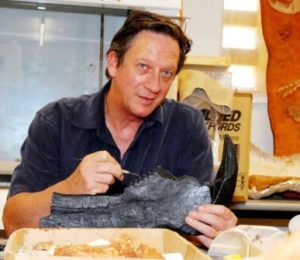
In a major evolutionary discovery, Flinders University palaeontologist Professor John Long (pictured) has found evidence to show that four-legged animals first developed the ability to breathe air as ancient fish in water.
Published yesterday (Thursday, January 23) in the international journal Nature Communications, the research shows the Polypterus, the most primitive living bony fish, breathes air through large canals on top of its head called spiracles.
The discovery marks the first step in the evolutionary transition of similar ancient fishes to the land as tetrapods, or four-legged animals.
Professor Long, the Strategic Professor in Palaeontology at Flinders, said the research points to the likely conclusion that the ancient Gogonasus – which belonged to a group of fish widely regarded by scientists as the ancestors from whom the first land animals evolved – originally developed its breathing abilities using its spiracles.
He said the groundbreaking discovery signals the origins of breathing for the four-legged descendants of these ancient fish.
“Polypterus had holes on top of its head but we never knew what they were actually for until we observed the fish over a long period of time and found they were breathing through their spiracles,” Professor Long said.
“Until now we’ve only had theories about the origins of breathing in the evolution of fish to land animals – some early 19th Century scientists had these wacky ideas that fish just jumped onto the land and started gasping for breath and developing limbs,” he said.
“But our research shows that the transformation actually started happening within the fish themselves while they were still in water.”
As part of the study, a team based at The Scripps Research Institute in the US observed species of Polypterus for 360 hours and measured the amount of oxygen it was taking in.
He said the findings on Polypterus is the “smoking gun” that points to fossils such as Gogonasus as being capable of breathing in air through their spiracles.
“Other lobed-finned fish fossils of that age show large spiracles on top of their heads and the earliest known tetrapod fossils also have large open spiracles on their heads.
“All this points to the ability of these fishes to take in air from their spiracles as the first type of breathing, which ultimately helped them leave the water and invade the land.”
Professor Long said once the four-legged descendants of the lobed-finned fish abandoned the water, the ability to breathe through their spiracles declined as they switched to breathing using their mouths and nostrils, as humans do today.
“The spiracles eventually became the hearing canal in which tetrapods transmitted sound to the brain via tiny inner ear bones, and this has remained throughout the evolution of fish right through to humans,” he said.
“If not for the bold evolutionary experiments of these prehistoric fish breathing in air through the top of their heads, we might not have evolved such a keen sense of hearing.”

